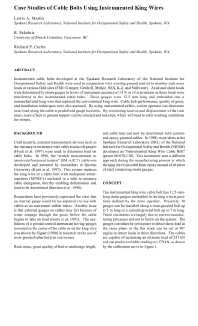Mining Publication: Case Studies of Cable Bolts Using Instrumented King Wires
Original creation date: July 2001
Instrumented cable bolts developed at the Spokane Research Laboratory of the National Institute for Occupational Safety and Health were used in conjunction with existing ground control to monitor rock mass loads at various field sites (FMC Granger, Getchell, Meikle, SSX, K-2, and Stillwater). Axial and shear loads were determined by strain gauges to levels of instrument accuracy of +/- N or +/- 5 microstrain as these loads were transferred to instrumented cable bolts. The gauges were 12.5 mm long and embedded into a remanufactured king wire that replaced the conventional king wire. Cable bolt performance, quality of grout, and installation techniques were also assessed. By using instrumented cables, a mine operator can determine axial load along the cable at predefined gauge locations. By monitoring load on and displacement of the rock mass, more effective ground support can be selected and installed, which will lead to safer working conditions for miners.
Authors: LA Martin, R Pakalnis, RP Curtin
Conference Paper - July 2001
NIOSHTIC2 Number: 20021385
In: D. Elsworth, J.P. Tinnucci, and K.A. Heasley, eds. Rock Mechanics in the Public Interest. Proceedings of the 38th U.S. Rock Mechanics Symposium, DC Rocks, Vol 1, (July 7-10, 2001; Washington, DC), Balkema, 2001 Jul; :1013-1020
See Also
- Analysis of Multiple Seam Stability
- Elastic and Shear Moduli of Coal Measure Rocks Derived from Basic Well Logs Using Fractal Statistics and Radial Basis Functions
- Large-Scale Strata Response to Longwall Mining: A Case Study
- Optimizing Secondary Roof Support with the NIOSH Support Technology Optimization Program (STOP)
- Pillar and Roof Span Design Guidelines for Underground Stone Mines
- Pillar Stability Issues Based on a Survey of Pillar Performance in Underground Limestone Mines
- Pillar Strength and Design Methodology for Stone Mines
- Reservoir Rock Properties of Coal Measure Strata of the Lower Monongahela Group, Greene County (Southwestern Pennsylvania), from Methane Control and Production Perspectives
- Stability of Underground Openings Adjacent to the Sink Hole at the NIOSH Lake Lynn Research Laboratory
- Volumetric Measurement of Rock Movement Using Photogrammetry
- Page last reviewed: 6/8/2016
- Page last updated: 9/21/2012
- Content source: National Institute for Occupational Safety and Health, Mining Program


 ShareCompartir
ShareCompartir
